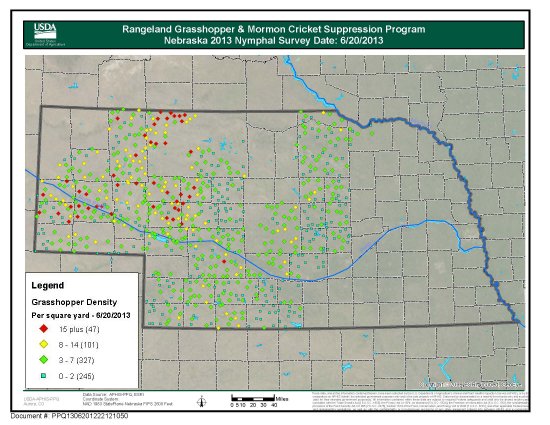
By Jeff Bradshaw, UNL Extension, Entomologist, Panhandle REC
This year the Panhandle is the area in Nebraska at greatest risk for damaging grasshopper feeding in rangeland, according to USDA Animal and Plant Health Inspection Service (APHIS) scouting reports. Overall surveys have revealed some of the lowest grasshopper densities statewide in years (Figure 1 http://go.unl.edu/3hh).
USDA APHIS provides regular updates on the status of rangeland grasshoppers across Nebraska.
Currently 3rd instar grasshoppers are beginning to appear in southwest Nebraska and some 4th instars are appearing in the Sandhills. The Panhandle grasshopper populations are just beginning to emerge with most being 1st instars.
Although numbers are low, some locations will benefit from scouting. Grasshoppers appear to be on the increase in the Sandhills per the latest survey. Many of these areas are in the American burying beetle habitat (http://go.unl.edu/5i8), so there are restrictions which require some communication with the U.S. Fish and Wildlife Service in order to legally treat those areas.
How to Estimate Grasshopper Density
The following method is based on information in the USDA Agricultural Research Service resource, Grasshoppers: Their Biology, Identification and Management, by James S. Berry et al. http://www.sidney.ars.usda.gov/grasshopper/Handbook/VI/vi_10.htm
The 18-square-foot sample method used by many APHIS offices in the western United States is a simple and quick way of determining the density of grasshoppers on rangeland. At each survey site, choose a sample area typical of the rangeland to be surveyed. Next, look ahead and determine the approximate route you will walk (Figure 2 http://go.unl.edu/q9j). Pick a spot on the ground about 10 paces in front of you. Choose the spot before you determine if any grasshoppers are present.
Visualize a sample area surrounding the spot equal to one square foot on the ground. You can use landmarks such as a stick, pebble, tuft of grass, or flower to help keep your eye focused on the sample area chosen. Or you can use a piece of wire bent into a one square foot (Figure 3 http://go.unl.edu/mgn) placed at your feet to help train your eye. Once the area is set, walk slowly toward it and determine the number of grasshoppers by counting the grasshoppers as they flush out of the visualized sample area.
Do not count individuals that hop into the sample area while conducting the sample count. When you reach the spot, probe the area with the handle of your insect net or other suitable object to make sure all individuals have flushed and been counted. Record the number counted and repeat the process at 17 more sample areas. The total number of grasshoppers counted in the 18 one-square-foot sample areas, divided by 2, gives you the number of grasshoppers per square yard.
Grasshoppers develop through four immature stages, or instars, prior to becoming winged adults. For optimal treatment, delay treatment until you begin to spot 3rd and 4th instars (Figure 4 http://go.unl.edu/hts). (For help with staging grasshoppers, see the UNL Department of Entomology Grasshopper website http://entomology.unl.edu/grasshoppers/index.shtml.) Treatment is warranted when grasshopper nymphs at the 3rd and 4th instar are spotted and the total number averages 25 to 30 per square yard.
Note that some areas of Nebraska may have restrictions on pesticide applications due to deleterious impacts to state or federally protected species. (Please refer to Nebraska information and distribution maps on the U.S. Fish & Wildlife Service website for details (http://go.unl.edu/4rp). However, producers and landowners can request a site specific survey to be conducted by APHIS. Contact your local Extension Office or call USDA-APHIS directly at 402-434-2345.